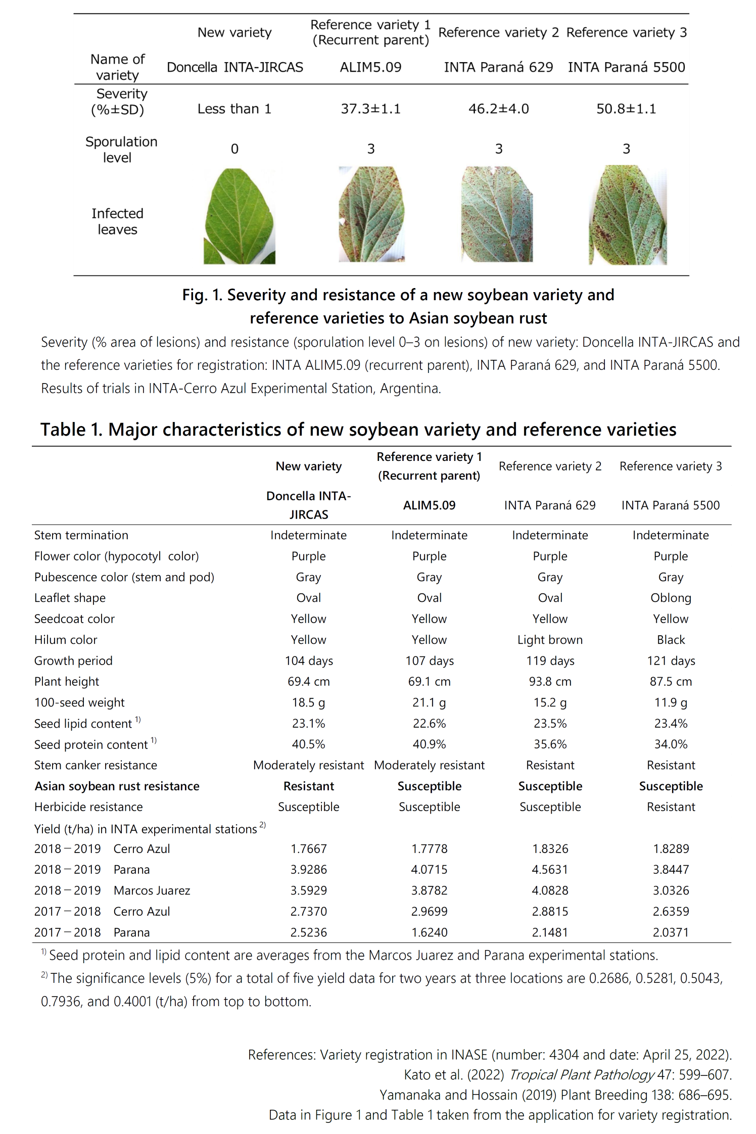Development of "Doncella INTA-JIRCAS," a new soybean variety with high Asian soybean rust resistance
Description
Asian soybean rust (ASR) is a serious soybean disease that accelerates defoliation and reduces yield of soybean. Farmers have been using fungicides for ASR control, but the fungicide resistance of the pathogen is increasing. The use of resistant varieties would reduce production cost and environmental impact by limiting the excessive use of fungicides. Resistance genes (Rpps) to ASR have been identified in soybean. In addition, JIRCAS has shown that soybean plants with multiple Rpp genes are not only resistant to many strains of the ASR pathogen with different virulence, but also show a high level of resistance to them. In this study, we developed a soybean variety with high ASR resistance adapted to Argentina, using the Rpp-pyramided lines bred by JIRCAS.
We crossed the ASR-resistant line "No6-12-1," which has three resistance genes (Rpp2, Rpp4, and Rpp5) developed by JIRCAS, as a non-recurrent parent and the variety "INTA ALIM5.09" from the National Agricultural Technology Institute (INTA), as a recurrent parent. The F1 individuals were then backcrossed to the recurrent parent, and individuals carrying the three resistance genes were selected using DNA markers. This process was done continuously, and the line with the best production characteristics was selected and registered in the National Seed Institute (INASE) of the Ministry of Agriculture, Livestock and Fisheries of Argentina as "Doncella INTA-JIRCAS." The official date of registration of the new soybean variety was April 25, 2022 (Variety Registration Number: 4304). The new variety was similar to the recurrent parent, INTA ALIM5.09, for major soybean traits such as stem termination (Table 1). However, ASR severity on the leaves in the field experiment was less than 1% for the new variety, compared to more than 30% for the recurrent parent, INTA ALIM5.09 and the reference varieties, INTA Paraná 629 and INTA Paraná 5500, indicating that the new variety has high ASR-resistance derived from "No6-12-1" (Fig. 1).
Because both infection and spore production of ASR are suppressed in the new variety (Fig. 1), fungicide use can be significantly reduced. Actually, soybean varieties developed in Paraguay by introducing the same gene combinations have yielded 1.4- or 1.7-fold higher than pre-improved varieties under fungicide-free conditions. However, in order to maintain the resistance of new varieties for a long time, it is necessary to suppress the emergence of new ASR pathogens that can break the resistance, so fungicides should be used in appropriate quantities and frequencies.
Figure, table
- Research project
- Program name
- Term of research
-
FY2012–2022
- Responsible researcher
-
Yamanaka Naoki ( Biological Resources and Post-harvest Division )
MIERUKA ID: 001770De Lucia Adrián ( Instituto Nacional de Tecnologia Agropecuaria )
Heck Mónica ( Instituto Nacional de Tecnologia Agropecuaria )
- ほか
- Publication, etc.
-
Variety registration in INASE (number: 4304 and date: April 25, 2022)Kato et al. (2022) Tropical Plant Pathology 47: 599–607.https://doi.org/10.1007/s40858-022-00516-xYamanaka and Hossain (2019) Plant Breeding 138: 686–695.https://doi.org/10.1111/pbr.12720
- Japanese PDF
-
2022_C01_ja.pdf1.54 MB
- English PDF
-
2022_C01_en.pdf993.34 KB
* Affiliation at the time of implementation of the study.

